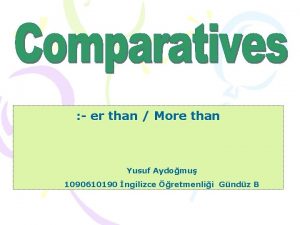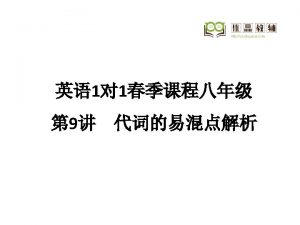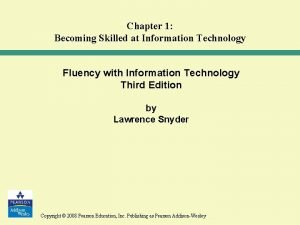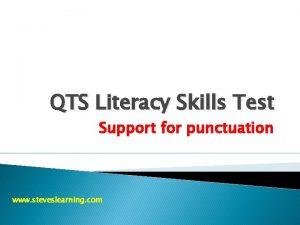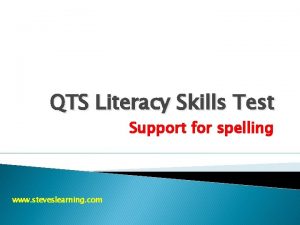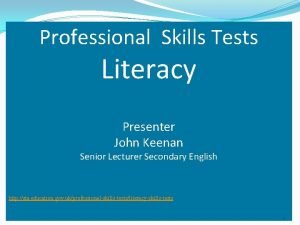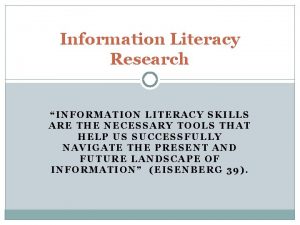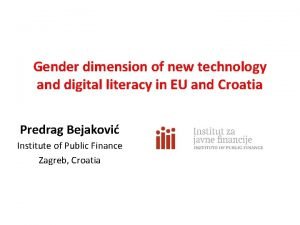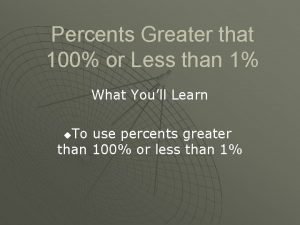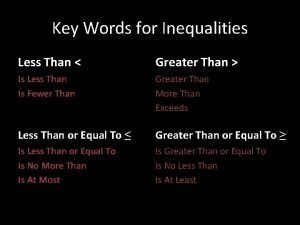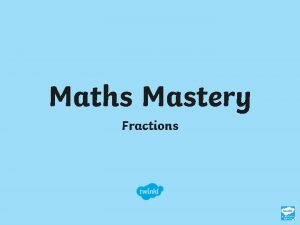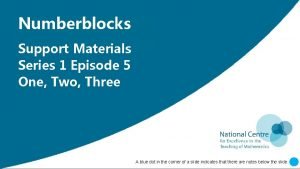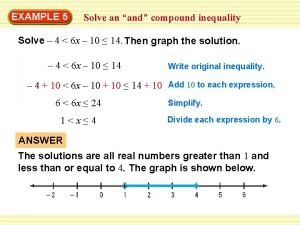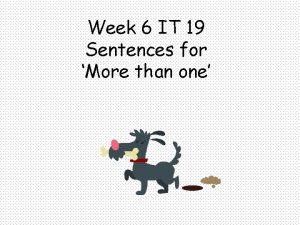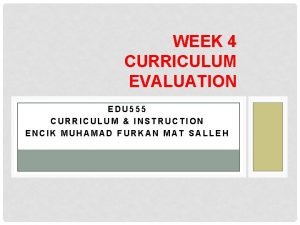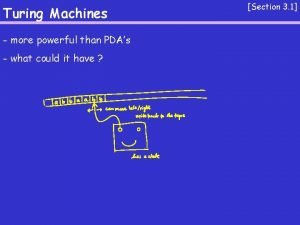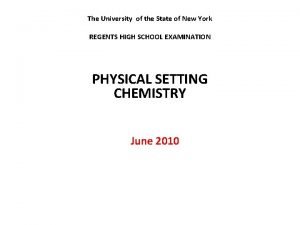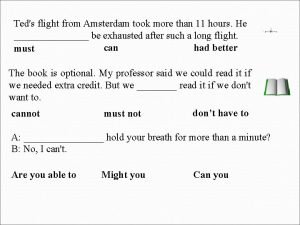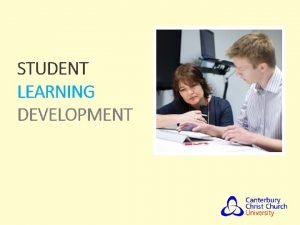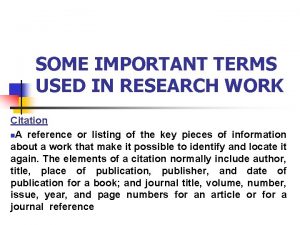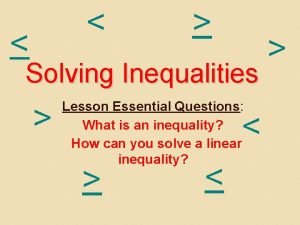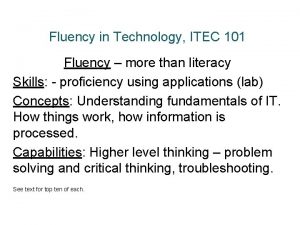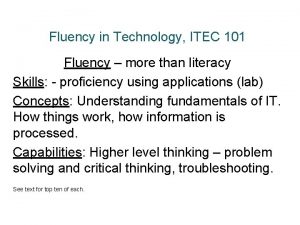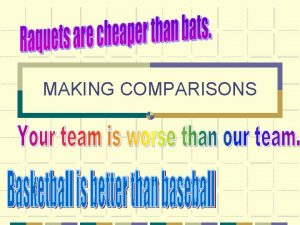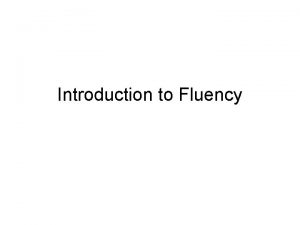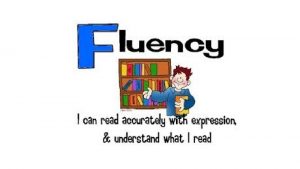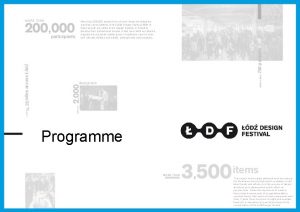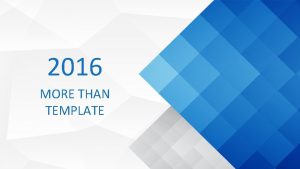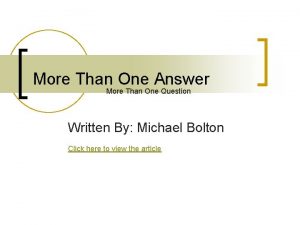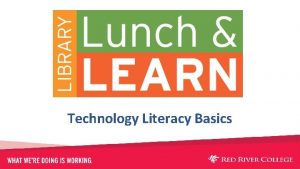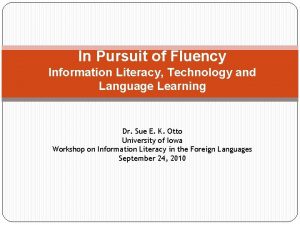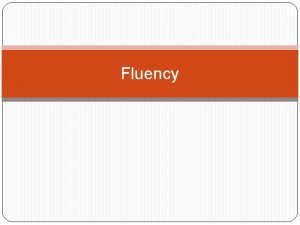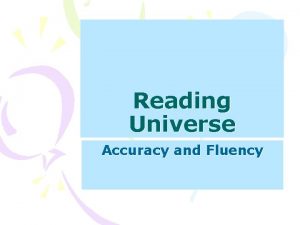Fluency in Technology Fluency more than literacy Skills































- Slides: 31

Fluency in Technology Fluency – more than literacy Skills: - proficiency using applications (lab) Concepts: Understanding fundamentals of IT. How things work, how information is processed. Capabilities: Higher level thinking – problem solving and critical thinking, troubleshooting. See text for top ten of each.

Terms of Endearment • Defining Information Technology – Learning the language of IT • Acronyms – WYSIWIG • Jargon – "Clicking around" • Metaphors – Everyday terms like "window" have special meanings in IT Copyright © 2006 Pearson Addison-Wesley. All rights reserved. 1 -2

Why Know Just the Right Word? • There are many new terms in IT – Terms are invented for ideas, concepts and devices that never existed before • Educated people use the right word at the right term – "le mot juste" (the right word) Copyright © 2006 Pearson Addison-Wesley. All rights reserved. 1 -3

Why Know Just the Right Word? (cont'd) • Terminology is basic to learning a new subject – Words represent ideas and concepts • Precision in word use represents precision in understanding idea • Communicating with others – To be able to ask questions and receive help – By email, by telephone, through online help facility Copyright © 2006 Pearson Addison-Wesley. All rights reserved. 1 -4

Two Basic Organizations • Component – Desktop PC's with separate components • • Monitor Hard Drive Speakers Etc. – Allows user to mix and match – Power switch on box with disk drives Copyright © 2006 Pearson Addison-Wesley. All rights reserved. 1 -5

Copyright © 2006 Pearson Addison-Wesley. All rights reserved. 1 -6

Two Basic Organizations (cont'd) • Monolithic – i. Mac or laptop has all devices bundled together – Simple and convenient – Power switch on chassis or keyboard Copyright © 2006 Pearson Addison-Wesley. All rights reserved. 1 -7

PC Motherboard • Printed circuit board inside processor box – Contains most of the circuitry of PC system Copyright © 2006 Pearson Addison-Wesley. All rights reserved. 1 -8

I-Phone motherboard From http: //thisbluemarble. com/ 1 -9

Motherboard (cont'd) • Smaller circuit boards, called daughter boards or cards, plug into motherboard for added functionality • Motherboard contains the microprocessor chip and the memory Copyright © 2006 Pearson Addison-Wesley. All rights reserved. 1 -10

Microprocessor • "Smart" part of system • Performs actual computing • "Micro" was adopted around 1980 to distinguish single chip circuitry from larger mainframes of the day. • Term is archaic. It is more correct to say "processor. " Copyright © 2006 Pearson Addison-Wesley. All rights reserved. 1 -11

Memory • Where program and data are located while program runs • RAM: Random Access Memory • PC Contains millions of bytes of RAM • What Random Access means – Any item can be retrieved directly – Unlike sequential access (ex. tapes) Copyright © 2006 Pearson Addison-Wesley. All rights reserved. 1 -12

Copyright © 2006 Pearson Addison-Wesley. All rights reserved. 1 -13

Hard Disk • High-Capacity, persistent peripheral storage device – Stores programs and data not in immediate use by computer – Made from magnetized iron compound • Information remains whether PC is on or off • Called permanent or persistent storage Copyright © 2006 Pearson Addison-Wesley. All rights reserved. 1 -14

Hard Disk (cont'd) • Small stack of bright metal washers with arm that sweeps across Copyright © 2006 Pearson Addison-Wesley. All rights reserved. 1 -15

Saving from RAM to Hard Disk • Saving moves information from RAM to hard disk – Successful user saves frequently • Ram memory is volatile – Information is lost when power turns off – If computer fails or power-cycles, only data on disk will survive Copyright © 2006 Pearson Addison-Wesley. All rights reserved. 1 -16

How Soft is Software? • Hardware is old term for metal items used in construction – Refers to physical parts of computer – Functions implemented directly with wires and transistors • Software is a term created for computers – Means programs or instructions the computer follows to implement functions Copyright © 2006 Pearson Addison-Wesley. All rights reserved. 1 -17

Algorithms and Programs • Algorithm – Precise and systematic method for solving a problem – Examples: • • Arithmetic operations Sending a greeting card Searching for a phone number Determining when a mouse pointer hovers over a button – Algorithms need to be precise Copyright © 2006 Pearson Addison-Wesley. All rights reserved. 1 -18

Algorithms and Programs (cont'd) • Writing out steps of algorithm is called programming – Program is an algorithm written in specific language for specific set of conditions • Running a Program – Click on program icon (ex. Netscape) – We instruct computer to run or execute or interpret the program from Netscape company that browses Internet. Copyright © 2006 Pearson Addison-Wesley. All rights reserved. 1 -19

Boot • Booting: Start computer • Rebooting: Re-start computer • Boot instructions are stored in a microchip called the boot ROM • Term comes from "bootstrapping", that is, to pull oneself up by one's bootstraps. Copyright © 2006 Pearson Addison-Wesley. All rights reserved. 1 -20

The Words for Ideas • Abstract: Remove the basic concept, idea, or process from a situation • Abstraction is a more succinct and generalized form of the removed concept. – e. g. , parables and fables (moral is abstracted from story) – Decide which details are relevant – Understand convey the same point to apply to many situations Copyright © 2006 Pearson Addison-Wesley. All rights reserved. 1 -21

"Generalize" • Recognize common idea in two or more situations • Summarize expression of idea, concept, or process that applies to many situations – e. g. , faucet handles usually turn left for on and right for off – Caps usually twist left to loosen, right to tighten • Remember that generalizations will not apply in every single situation Copyright © 2006 Pearson Addison-Wesley. All rights reserved. 1 -22

"Operationally Attuned" • Being aware of how a gadget works • Apply what we know about how device or system works to simplify use – e. g. , cap lids usually twist less to loosen, so we are confident about which way to twist if stuck • Thinking about how IT works makes it simpler to use technology Copyright © 2006 Pearson Addison-Wesley. All rights reserved. 1 -23

"Mnemonic" • Memory aid – How to pronounce words and phrases – e. g. , 5 Great Lakes are HOMES (Huron, Ontario, Michigan, Eire, Superior) – PILPOF - Plug in last, pull out first • Helps simplify use of technology – Easy memorization of infrequently used details Copyright © 2006 Pearson Addison-Wesley. All rights reserved. 1 -24

Analytical Thinking • Use specific facts and comparisons to back up statements • Non-analytical statement: – World record in the mile run has improved • Analytical statements: – In 45 years, the world record in the mile has improved from 3. 59. 4 to 3. 43. 13, a 7% improvement – The average 20 year old can run a mile in 7. 5 minutes. The world record holder is twice as fast. Copyright © 2006 Pearson Addison-Wesley. All rights reserved. 1 -25

Factor of Improvement • As a percentage – Divide the new rate by the old rate – New rate is 7% faster • As a factor: – New rate is factor-of-1. 07 times faster than old rate, and factor-of-2 times faster than average person Copyright © 2006 Pearson Addison-Wesley. All rights reserved. 1 -26

Copyright © 2006 Pearson Addison-Wesley. All rights reserved. 1 -27

Super Computers • Analytical comparison of computer speeds – UNIVAC I • First commercial computer released in 1951 • Rate of 100, 000 addition operations (adds) per second – Today's Thinkpad • Affordable laptop system • Rate of 1 billion adds per second • Factor of 10, 000 improvement over UNIVAC – ASCI Red • Intel Computer built for Sandia National Labs • Rate of 2. 1 trillion floating points (decimal) adds per second • Factor of 21 million improvement over UNIVAC Copyright © 2006 Pearson Addison-Wesley. All rights reserved. 1 -28

Benefits of Analytical Thinking • Learning specific facts, and comparing to other specific facts • Putting things in perspective – Factor of 1. 07 improvement in mile run record does not seem small when compared to factor of 2 difference between world record holder and average person Copyright © 2006 Pearson Addison-Wesley. All rights reserved. 1 -29

Defining WYSIWYG • First acronym in this chapter – "What you see is what you get" – Text is stored in memory as long line of letters, numbers, punctuation, etc. – Original text editing software could not display formatting; users had to guess what it would look like when printed – WYSIWYG processes display of data as formatted page Copyright © 2006 Pearson Addison-Wesley. All rights reserved. 1 -30

Copyright © 2006 Pearson Addison-Wesley. All rights reserved. 1 -31
 More more more i want more more more more we praise you
More more more i want more more more more we praise you More more more i want more more more more we praise you
More more more i want more more more more we praise you Mil picture analysis
Mil picture analysis Media literacy vs information literacy comparison
Media literacy vs information literacy comparison Generous kelimesinin comparative hali
Generous kelimesinin comparative hali Half life more than 2 less than 4
Half life more than 2 less than 4 Better than god
Better than god Fluency with information technology
Fluency with information technology Information technology fluency
Information technology fluency Example of types of media
Example of types of media Cyber literacy and digital literacy
Cyber literacy and digital literacy Qts literacy test
Qts literacy test Early literacy skills checklist
Early literacy skills checklist Literacy skills test spelling
Literacy skills test spelling Literacy professional skills test
Literacy professional skills test Big six information literacy skills
Big six information literacy skills What is technology literacy
What is technology literacy Percents greater than 100 and less than 1
Percents greater than 100 and less than 1 Fractions greater less than or equal to
Fractions greater less than or equal to Key words for inequalities
Key words for inequalities Fraction odd one out
Fraction odd one out Jesus lord of heaven
Jesus lord of heaven Numberblocks 10
Numberblocks 10 Greater than less than examples
Greater than less than examples More than in a sentence
More than in a sentence According to wentling (1980), evaluation must do more than
According to wentling (1980), evaluation must do more than More powerful than turing machine
More powerful than turing machine Which equation represents sublimation?
Which equation represents sublimation? Ted's flight from amsterdam
Ted's flight from amsterdam How to cite more than one author
How to cite more than one author Parenthetical citation for multiple authors
Parenthetical citation for multiple authors How to calculate ratio
How to calculate ratio




